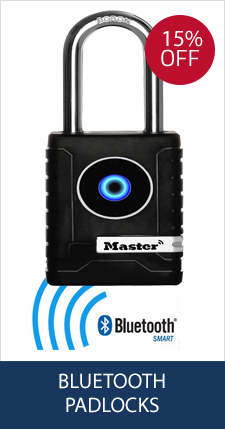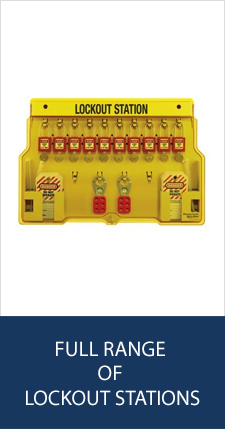Safety Lock Out Padlocks
Safety lock out padlock is meant to provide a measure of safety beyond that offered by a tag alone. Used properly in conjunction with a well-planned lockout process, the safety padlock helps ensure that employees will not inadvertently energize a piece of equipment while someone else is working on it.
The first rule in choosing a padlock for lockout is to ensure the lock looks different than those used in the facility for locking toolboxes, gates, etc. This often is done by the use of bright colours. The most popular lockout padlocks have a “Danger” label incorporated on them, which includes employeename, photo or both.
The second rule revolves around the mantra of “one employee, one key”. This means all employees carry a unique key, and no one else’s key can open the other employee’s safety padlocks. A single employee may carry any number of padlocks, all keyed to that same key for convenience (called KA – Keyed Alike), but no one else should have a key that can open another employee’s padlocks. This means that you should choose a padlock that offers enough unique key numbers to serve all your current employees, and that you should leave room for future growth. Master Lock offers over 40,000 key codes in the 410 and 411 Safety padlocks. Aluminum safety padlocks offer 10,000 to 101,000 key codes. The laminated steel padlock offers 1,400 codes.
Key Charting
Master Lock offers a free key charting service to help ensure locks ordered for a particular facility are unique and there are no duplicates. Register your system by supplying your facility name and address on the Key Charting Registration Form.
You may also add key codes already in your existing system by filling in and submitting a “Key Code” spreadsheet to Master Lock. The key codes are a mix of numbers and letters found engraved on the key.
Once you have registered your facility, Master Lock will issue a registration number to you. When you order more padlocks from your supplier be sure to include this registration number to ensure new, unique key cuts are used when your padlocks are manufactured.
Safety Padlock Construction
Master Lock offers safety padlocks made of Zenex™ engineered plastic, aluminum, or steel. Each type offers unique characteristics that may make one better for your lockout environment.
410 and 411 Zenex™ Composite Padlocks
Models 410 and 411 use a GE Plastics Zenex™ composite material made up of polycarbonate, polyester, mineral, and glass fibers. This makes for a durable, light padlock that is easy to carry and stands up to drops, corrosive environments, moisture, and UV.
Zenex™ will function in high and low temperatures. We have successfully tested locks at -70 and up to +350 degrees Fahrenheit. Zenex™ has high tensile strength. It does not absorb moisture. It is also very chemical resistant. The blend we use also offers stability to UV exposure.
Zenex™ padlocks were designed specifically for lockouts. In addition to their strength and light weight, they include labels that alert others that they are lockout padlocks and identify to whom the padlock belongs. The inclusion of the label allows many facilities to eliminate the redundant tag. The 410 includes “Danger” labels in English, Spanish, and French. The taller 411 includes bilingual English/Spanish and English/French labels. Other languages are available for use outside of North America.
Model 6835 and 6836 Aluminum Padlocks
Aluminum offers high resistance to environmental corrosion. A powder coat finish provides a durable bright color to the safety padlock. “Danger – Lockout” labels are available (purchase separately). Tested temperature operating range -70 degrees F to +350 degrees F. Available in 6 unique colors. Aluminum can be laser engraved.
Model A1105, A1106, A1107 Aluminum Padlocks
Similar to the 6835, but the finish is anodized. Allows for use in food processing facilities where a powder coated “paint” finish may not be acceptable. Available in 9 unique colors.
Model 3 Steel Padlock
Strong. Steel stands up to abusive handling. Size of padlock limits the number of key changes available, so these locks are recommended for smaller facilities that will not grow beyond 1400 employees, thus corresponding to the 1400 available codes for steel padlocks. Cadmium coating provides corrosion resistance. Differentiation from security padlocks is provided by the use of a colored plastic bumper. Tested Temperature operating range -70 degrees F to +210 degrees F. It is the heaviest safety padlock, so if you have to carry many safety padlocks, you may wish to use the lighter Zenex™ or aluminum instead. Available with 6 different color bumpers.
Durability
A high security padlock is designed to keep a determined thief from prying, picking, cutting or hammering a lock off. While providing a good level of security, safety padlocks are not specifically designed to provide resistance to physical attacks. While providing a strong, durable lock is important, the most important consideration in a safety lockout is that the keying system used provides a large number of key choices and is not susceptible to key interchange. Key interchange is when another person’s key can accidentally open your lock. Master Lock uses high precision key cylinders in our Zenex™ and aluminum safety padlocks.
Resistance to Attack
Tested to ASTM F883. For security padlocks a higher grade number is better. Grade 6 is the highest rating. A typical high security padlock will have grade 4 or higher on all physical attack tests






Comments
Leave your comment